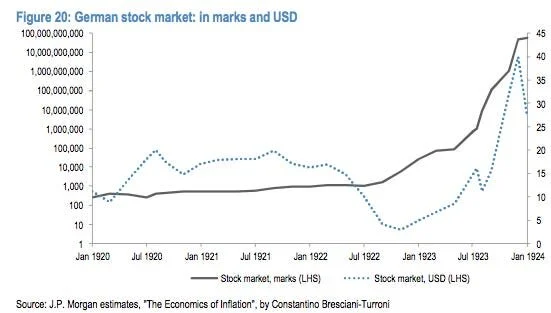Inflationary Stock Market Recessions
Inflationary Stock Market Recessions
(Most) people believe that stocks declining will herald the next recession. Indeed, in 1929 (Great Depression), 2001 (Dotcom bubble), and 2008 (Great Recession), the stock markets all declined in price. A notable exception was the German stock market in 1923.
In post WWI Weimar Germany during the early 1920’s, the stock market actually increased by orders of magnitude while the economy went into a recession. The reason is that Rudolf Havenstein, president of Germany’s central bank, the Reichsbank, decided to print money to solve the dual economic problems of Germany losing WWI and paying reparation debts to the victors.[1]
The German stocks were not actually increasing in value- just price. The Mark, Germany’s paper money, was decreasing in value, so the price of everything was increasing.
Since the start of the Great Recession, central banks around the world have been printing money to inflate the price (but not value) of their stocks.[2]
Editor’s note: the above graph does no account for 2019 when central banks began to print money again.
From 2008 until early 2015, the Federal Reserve was printing money and increasing its assets. In Dec 2015, the Fed began to allow interest rates to slowly rise. From early 2018 until September 2019, the Fed was selling assets because the economy was allegedly improving. Since September anduntil December 4th, the Federal Reserve has bought over $300 billion of assets by printing money.[3][4] What changed?[5]
The Federal Reserve Bank of Saint Louis’s Economic and Research division’s economists Scott A. Wolla and Kaitlyn Frerking have published a paper in November entitled, “Making Sense of the National Debt.” In it they comment on Germany’s inflation. To wit,[6]
“Economist Herb Stein once said, ‘If something cannot go on forever, it will stop.’ In other words, trends that are unsustainable will not continue because the economy will adjust, sometimes in abrupt and jarring ways. While governments never have to entirely pay off debt, there are debt levels that investors might perceive as unsustainable. A solution some countries with high levels of unsustainable debt have tried is printing money. In this scenario, the government borrows money by issuing bonds and then orders the central bank to buy those bonds by creating (printing) money. History has taught us, however, that this type of policy leads to extremely high rates of inflation (hyperinflation) and often ends in economic ruin. Some of the better-known examples of such polices are Germany in 1921-23, Zimbabwe in 2007-09, and Venezuela currently.”
The debt of the US has been increasing at the Federal, State, local, and personal level for the entirety of the author’s life from $3 trillion to $23 trillion.[7] The Federal debt doubled under Bush, Obama, and is set to double again under Trump (assuming he is in office for 8 years). In order for the debts to be affordable, the Federal Reserve has to monetize the debt (print money).
Henry Hazlitt was right,[8]
“Today is already the tomorrow which the bad economist yesterday urged us to ignore.”
Increasing stock prices in 1923 did not reflect the strength of the Weimar German economy; rather, the prices reflected how much the German money was losing value. Do not simply look to stocks declining to predict a recession. Look to banks printing money and why: debt.
End Note: On November 8th and 9th 1923, Hitler attempted his “Beer Hall Putsch” to try to rally a revolution for his National Socialist German Worker’s Party to overthrow the government causing hyperinflation.
He failed but the subsequent radio broadcast of his trial, where he was allowed to speak at length, gave him increasing support which he used 10 years later to be elected Chancellor of Germany.
We need to learn from our past so we do not repeat their mistakes.
Never again
[1] https://mises.org/library/hyperinflation-germany-1914-1923 “By the end of the war the amount of money in circulation had risen fourfold and prices some 140 percent. Yet the German mark had suffered no more than the British pound, was somewhat weaker than the American dollar but stronger than the French franc. Five years later, in December 1923, the Reichsbank had issued 496.5 quintillion marks, each of which had fallen to one-trillionth of its 1914 gold value.”
[2] https://www.zerohedge.com/news/2019-10-23/central-banks-begin-panic
[3] https://fred.stlouisfed.org/series/WALCL
[4] https://www.hamiltonmobley.com/blog/not-qe
[5] https://www.hamiltonmobley.com/blog/risky-debt “The Repo Rate is the interest rates which banks pay on overnight lending backed by bonds as collateral. It hit all-time highs on Sunday night [Sept 15] (7%) and Monday night [Sept 16] (10%).[1] Interest rates are rising in the repo market because either there is not enough money to be used for loans or people do not want to loan risky banks money at low interest rates.”
[6] https://research.stlouisfed.org/publications/page1-econ/2019/11/01/making-sense-of-the-national-debt
[8] http://www.hacer.org/pdf/Hazlitt00.pdf
pg. 5





